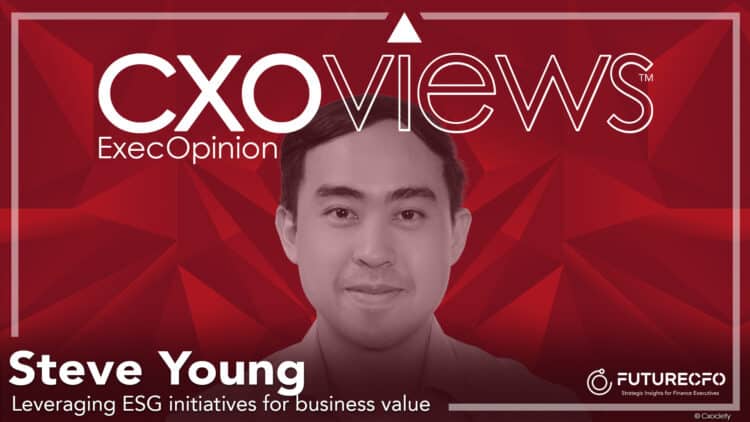Finance leaders are wedged into a position of not only overseeing the implementation of financial controls and risk management strategies to safeguard their organisations throughout the transformation journey, but also in spearheading the company to find and implement initiatives to drive value.
Chief financial officers indeed play a pivotal role in the company’s digital transformation as they are in charge of aligning financial goals with technological advancements, but as the Finance function undergoes several shifts to keep up with the market, they also face tasks of fulfilling newer roles.
One of which, of course, is ESG.
Communicating the initiatives of the organisation surrounding environmental, social, and governance has to be on point to maximise benefits and avoid wasting time and resources.
Steve Young, lead adjunct trainer, Boston Consulting Group, believes that the full organisation has to be brought onboard and be equipped on their priorities and key initiatives on ESG.
"The leadership team and employees are your ambassadors who are best placed to consistently share ESG progress with multiple stakeholders that they meet and can take back external learnings and best practices in their line of work," Young says.
Apart from this, Young notes that there are also numerous ESG reporting standards that an organisation can choose from to formally engage external stakeholders: depending on its size and the location of its main target audience. Such include Global Reporting Initiative (GRI), International Sustainability Standards Board (ISSB), Carbon Disclosure Project (CDP) or B Corp.
Where to start
In working through the implementation of ESG initiatives, finance leaders must have a full grasp of where to start. They must understand the specific ESG concerns and priorities of stakeholders in the Asian market to know how they can align their ESG strategy.
Young says there is an increasing demand for organisations to grow profitably but responsibly.
For this matter, in the area of environment, key stakeholders, especially consumers and shareholders, over time are looking to support organisations who can best balance 'People, Profit and Planet priorities'.
"Companies who can develop products that are truly benefitting and relevant to the consumer (People) while being efficient and using the right business models (Profit) and promoting sustainability (Planet) will have a distinct competitive advantage," says Young. "Stakeholders are also looking for authenticity and consistency in a company’s messaging versus its actual in-market practices."
Further, stakeholder concerns are manifested through numerous legal and regulatory ESG standards that are emerging, many of which are specific on a by country basis.
"I would encourage you to work closely with your partners (e.g. Finance, Legal, External Relations) to create a dashboard of material regulatory requirements, along with a clear point person who would be overall responsible for driving timely compliance," Young says.
Financial risks
In quantifying the financial risks associated with organisation's non-ESG-compliant practices in Asia, Young says this can be looked at as not being forward-looking in three ways.
Firstly, Young explains, there are risks to an organisation’s Margin Structure. "For example, in the area of sustainability, there are progressively increasing carbon-related taxes, both in Asia and for organisations who supply to developed countries like Europe, and costs for traceability and regulations compliance."

He adds that there are also costs for ensuring business continuity in the face of more frequent extreme weather events and disruptions, as well as on increasing financial and reputational penalties for not being compliant in the area of workers rights/ ethical supply chains and for governance and internal control lapses.
Second, Young says there are risks to a Sales Growth standpoint. "Organisations who are unable to create meaningful sustainable offerings will miss out on potential business growth with 'green minded' consumers. More consumers are also using sustainability and ESG to filter which companies/products they choose to buy from."
"Thirdly, there are risks on a Cash Efficiency standpoint. A company may spend more on capital in the long run if it has to retrofit facilities to comply with unanticipated ESG standards."
Young explains that as customers and financial institutions become sustainability conscious and require their partners to be increasingly ESG compliant, financing flow can be constrained for less preferred partners.
Conversely, according to Young, organisations that embrace the essence of ESG early on have a higher chance of turning these risks into opportunities: via upfront business planning, creating an early competitive advantage and establishing a 'sustainability equity' with their key stakeholders.
ESG spending
Assessing the cost-effectiveness of various ESG initiatives and investments for organisation in the Asian context may not be a cakewalk, as finance leaders are tasked to prioritise the most financially viable options.
In dealing with this, Young explains that he typically frame spending on ESG and Sustainability into three buckets:
- As a "Saving": Many of the efforts on sustainability usually call for scrutinising one’s operations then being more efficient on materials, energy/resource use and avoiding wastage. These are typically beneficial on costs and "lower hanging fruit" that should be prioritised.
- As an "Investment": For example, companies invest in capital and people resources to develop greener products or technology that are consumer relevant. If done properly and timely, this can enhance shareholder value as this enables introducing premium business models, or wresting market share from competitors.
- As a "Cost": This could refer to compliance related spending or the spending to "catch up" with competitors who were more forward looking. The spending would have to be weighed against the risk of penalties for being non-compliant or business loss for not keeping up.
For new and sizeable investments, considering that sustainability is a relatively new area, Young says it is prudent to perform 'proof of concept testing' to validate assumptions and enable pacing across a longer time horizon.
Young believes that there is a big overlap between sustainability and the opportunity for cost savings.
"Based on my experience as a supply chain finance business partner, I would recommend the organisation do a step-by-step 'process mapping' exercise to see optimisation opportunities in its supply chain on materials and energy use, as well as avoiding wastes."
He adds that one can also work with design teams (e.g. R&D/Marketing) to probe where opportunities exist in the use of materials and packaging in the product, relative to what consumers are willing to pay for. "Products that are consumer relevant, are 'green' by causing less clutter and then supported by appropriate communication to consumers, customers and ecosystem partners are great for building business."
Collaboration
In the journey, as with other strategies and initiatives, effectively collaborating with other departments is necessary to ensure a cohesive and impactful ESG strategy for the organisation.
"In my experience, sustainability is best achieved by an organisation culture where every individual feels empowered and plays a part in improving sustainability," Young says. "A best practice is to assign a point person (or group) who leads stakeholder engagement on sustainability goals and leads a visible drumbeat to ensure the multifunction is cohesive in implementing sustainability plans. This group is responsible for policy setting, training and deploying scalable tools (e.g. playbooks and digital tools) to make sustainability easier for rest of the organisation."
He adds that key performance indicators, as well as rewards and recognition that drive the right sustainability behaviours should also be set upfront for decision makers.



